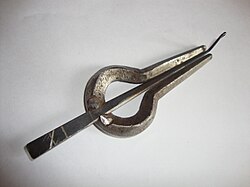 | |
| Classification | hand percussion |
|---|---|
| Hornbostel–Sachs classification | 121.2 |
| Playing range | |
| struck using the other hand to produce sound. | |
The morsing (also mukharshanku, mourching, morching or morchang; Sanskrit: दंत वाद्यन्तरात्मसत्रस्य, Telugu: మోర్సింగ్, Kannada: ಮೋರ್ಸಿಂಗ್, Rajasthani: मोरचंग, Tamil: நாமுழவு அல்லது முகச்சங்கு, Malayalam: മുഖർശംഖ്, English: "jaw harp") is an instrument similar to the Jew's harp, mainly used in Rajasthan, in the Carnatic music of South India, and in Sindh, Pakistan. It can be categorized under lamellophones, which is a sub-category of plucked idiophones. The instrument consists of a metal ring in the shape of a horseshoe with two parallel forks which form the frame, and a metal tongue in the middle, between the forks, fixed to the ring at one end and free to vibrate at the other. The metal tongue, also called the trigger, is bent at the free end in a plane perpendicular to the circular ring so that it can be struck and made to vibrate.[1]

The morsing can be traced back over 1500 years. They banged on the fishbone and a musical sound was produced. Though its exact origin in the Indian subcontinent is not well documented, with most ancient accounts being derived from folk tales secondary source. It is found mainly in South India, Rajasthan and some parts of Assam. In Bengali and Assamese folk music it is sometimes played with a Rabindrasangeet, while in South India, it features in Carnatic concerts and percussion ensembles. In Rajasthan it is known as morchang and is used as a percussion instrument in lok geet (folk music). It was often used in Hindi cinema by music directors like R.D. Burman and S.D. Burman, and has resurfaced in the twentieth century, with street performers like Varun Zinje playing it in a renewed style.[2] It is said to be the precursor to subsequent instruments such as the harmonica and the harmonium.[2]
- ^ "The morchang: an iron jews harp from Rajasthan". YouTube. Asian Music Circuit. Archived from the original on 13 December 2021. Retrieved 28 July 2015.
- ^ a b "Saving the jaw harp: Varun Zinje a.k.a. Morchangwala at TEDxEMWS". Tedx. YouTube. Archived from the original on 13 December 2021. Retrieved 28 July 2015.
